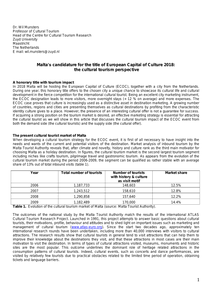Sustaining historical buildings does not always align with the ambition to promote sustainability in the built environment. In this paper we explore the dynamics and strategies that spring from this basic tension, by investigating the differences and similarities between expert’s valuation and peoples’ valuation of historical buildings, as well as their views on energy efficiency. Our paper highlights mediaeval churches in Groningen, which represent an important European heritage. We cooperate closely with the SOGK, a regional organization that is taking up the challenge of maintaining these churches in a region that is depopulating, secularizing and, to all that, suffering from earthquakes.
MULTIFILE

In this paper we investigate laypersons’ valuation of historic buildings, their experiences of thermal comfort in those buildings and contrast this with their views on the appropriateness of energy efficiency measures. This paper presents four case studies of medieval churches in Groningen, Netherlands. Valuation studies is used to investigate the values that are attached to historic buildings by various stakeholders. We apply the ‘heritage as a spatial vector’ approach, to position heritage in relation to developments in society and the landscape. Our theoretical contribution lies in the combination of heritage approaches and valuation studies. We conclude that for a more balanced assessment of historic buildings, laypersons’ valuations should be further integrated in heritage studies.
DOCUMENT

The paper briefly describes the outcome of two inventories: 1) an inventory based on fact sheets about daily use and energy consumption of historical buildings (mainly relative small churches) in the North of the Netherlands, and; 2) an inventory based on interviews with owners of historical buildings about motives to reduce energy consumption.
DOCUMENT

In their attempts to offer visitors meaningful experiences in historical churches, museums are increasingly experimenting with augmented reality. Arguing that an augmented reality experience should be counted as a material event in its own right, I focus on the aesthetic strategies employed in two augmented reality experiences. The first is an augmented virtuality installation that was presented in the Old Church in Amsterdam (Netherlands). The second concerns a HoloLens experience hosted by St. Peter’s Church in Leuven (Belgium). Drawing on the work of Gernot Böhme (2017) and undertaking a sensory auto-ethnography, I demonstrate how bodily sensations in these augmented reality experiences altered my affective involvement with the church spaces. I found that strategies of defamiliarisation and fragmentation affected my disposition, effectively personalising the perceptional relationship between the church as an authoritative institution and myself in the role as the visitor. Building on recent discussions on museums’ function in society, I also discuss the potential of augmented reality experiences to play on a multitude of meanings, and particularly, in staging dispositions that move away from universal truths.
DOCUMENT
Flipping the Classroom is hot in onderwijsland, iedereen praat erover en veel docenten zijn er al mee aan de slag gegaan. Maar wat is Flipping the Classroom nu eigenlijk ? Wat is de relatie met de taxonomie van Bloom? En waar moet je allemaal aan denken als je als docent aan de slag wil met Flipping the Classroom?
DOCUMENT

What kinds of live music are available to the citizens of the cities of Groningen and Utrecht? That is the main question in two research projects, of which the databases have been made accessible in the Dataverse City Musicscapes (Lelieveldt & Bisschop Boele, 2018). At first sight databases of statistical research offices provide researchers with clear data about the number of venues and concerts and the participation of audiences (Gemeente Utrecht 2017, Van den Broek 2014). When looking closer we find that in these statistics only the regular (and mainly publicly funded) music venues are included. The authors’ projects show that a substantial part (53–60%) of live music concerts take place on non-regular locations, such as cafés, restaurants, clubs, churches, shopping malls and in open air. They developed a research tool to be able to draw a map of the musical landscape of a city (Musicscape). In this article we will reflect on the goals, research methods, datasets and some results from analysing our datasets. We hope this contributes to the discussion with scholars, music producers and policy makers about the added value of the concept of Musicscapes for the understanding of cultural participation, music performing practices and cultural policies.
DOCUMENT
De kandidatuur van Malta als Europese Culturele hoofdstad in cultuurtoeristisch perspectief
DOCUMENT

Biographical information of Jan Floris de Jongh
DOCUMENT
